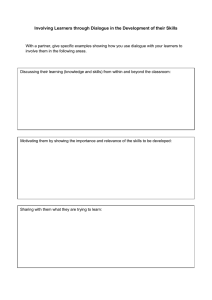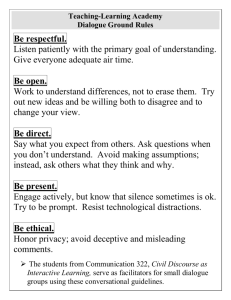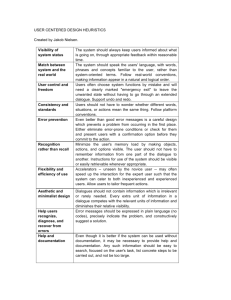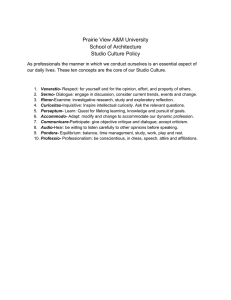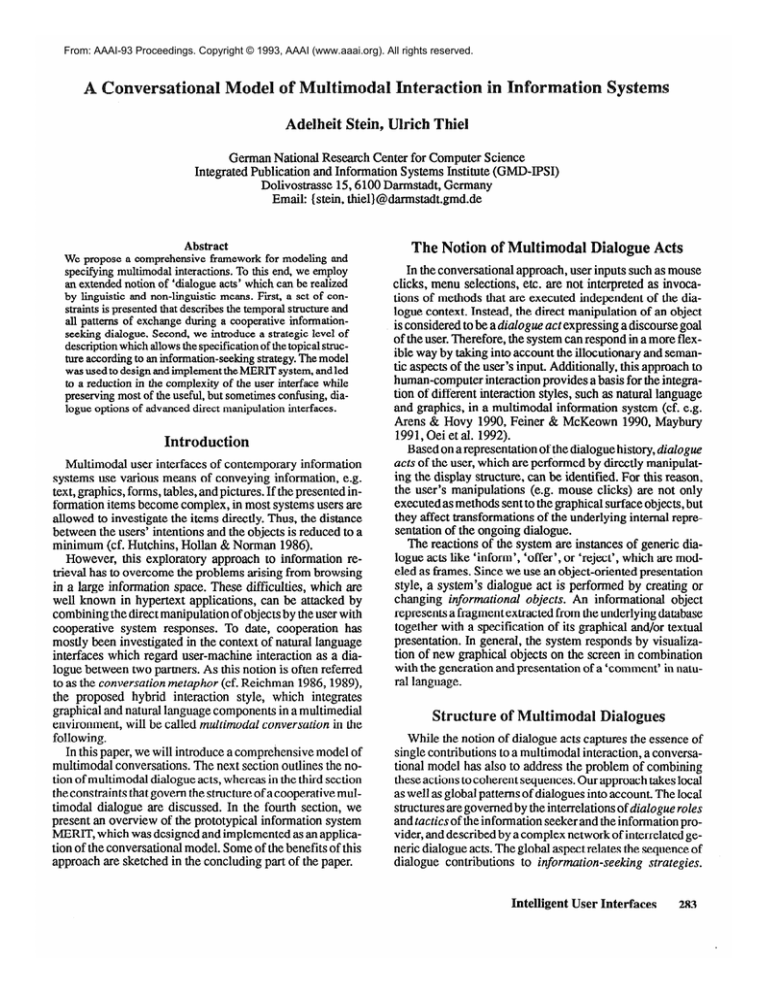
From: AAAI-93 Proceedings. Copyright © 1993, AAAI (www.aaai.org). All rights reserved.
Adelheit Stein, Ulrich Thiel
German National Research Center for Computer Science
Integrated Publication and Information Systems Institute (GMD-IPSI)
Dolivostrasse 15,610O Darmstadt, Germany
Email: (stein, thiel} @darmstadt.gmd.de
Abstract
We propose a comprehensive framework for modeling and
specifying multimodal interactions. To this end, we employ
an extended notion of ‘dialogue acts’ which can be realized
by linguistic and non-linguistic means. First, a set of constraints is presented that describes the temporal structure and
all patterns of exchange during a cooperative informationseeking dialogue. Second, we introduce a strategic level of
description which allows the specification of the topical structure according to an information-seeking strategy. The model
was used to design and implement the MERIT system, and led
to a reduction in the complexity of the user interface while
preserving most of the useful, but sometimes confusing, dialogue options of advanced direct manipulation interfaces.
Introduction
Multimodal user interfaces of contemporary information
systems use various means of conveying information, e.g.
text, graphics, forms, tables, and pictures. If the presented information items become complex, in most systems users are
allowed to investigate the items directly. Thus, the distance
between the users’ intentions and the objects is reduced to a
minimum (cf. Hutchins, Hollan & Norman 1986).
However, this exploratory approach to information retrieval has to overcome the problems arising from browsing
in a large information space. These difficulties, which are
well known in hypertext applications, can be attacked by
combining the direct manipulation of objects by the user with
cooperative system responses. To date, cooperation has
mostly been investigated in the context of natural language
interfaces which regard user-machine interaction as a dialogue between two partners. As this notion is often referred
to as the conversation metaphor (cf. Reichman 1986,1989),
the proposed hybrid interaction style, which integrates
graphical and natural language components in a multimedial
environment, will be called multimodal conversation in the
following.
In this paper, we will introduce a comprehensive model of
multimodal conversations. The next section outlines the notion of multimodal dialogue acts, whereas in the third section
the constraints that govern the structure of a cooperative multimodal dialogue are discussed. In the fourth section, we
present an overview of the prototypical information system
MERIT, which was designed and implemented as an application of the conversational model. Some of the benefits of this
approach are sketched in the concluding part of the paper.
In the conversational approach, user inputs such as mouse
clicks, menu selections, etc. are not interpreted as invocations of methods that are executed independent of the dialogue context. Instead, the direct manipulation of an object
is considered to be a dialogue act expressing a discourse goal
of the user. Therefore, the system can respond in a more flexible way by taking into account the illocutionary and semantic aspects of the user’s input. Additionally, this approach to
human-computer interaction provides a basis for the integration of different interaction styles, such as natural language
and graphics, in a multimodal information system (cf. e.g.
Arens & Hovy 1990, Feiner & McKeown B990, Maybury
1991, Oei et al. 1992).
Based on a representation of the dialogue history, dialogue
acts of the user, which are performed by directly manipulating the display structure, can be identified. For this reason,
the user’s manipulations (e.g. mouse clicks) are not only
executedas methods sent to the graphical surface objects, but
they affect transformations of the underlying internal representation of the ongoing dialogue.
The reactions of the system are instances of generic dialogue acts like “inform’, ‘offer’, or ‘reject’, which are modeled as frames. Since we use an object-oriented presentation
style, a system’s dialogue act is performed by creating or
changing informational objects. An informational object
represents a fragment extracted from the underlying database
together with a specification of its graphical and/or textual
presentation. In general, the system responds by visualization of new graphical objects on the screen in combination
with the generation and presentation of a ‘comment’ in natural language.
While the notion of dialogue acts captures the essence of
single contributions to a multimodal interaction, a conversational model has also to address the problem of combining
these actions to coherent sequences. Our approach takes local
as well as global patterns of dialogues into account. The local
structures are governed by the interrelations of dialogue roZes
and tactics of the information seeker and the information provider, and described by a complex network of interrelated generic dialogue acts. The global aspect relates the sequence of
dialogue contributions to information-seeking strategies.
Intelligent User Interfaces
283
Thus, a system is able to plan the content of subsequent dialogue steps according to principles of topical coherency.
The Conversational Roles Network
A formal schema of information-seeking dialogues allows
dialogues to be modeled at the discourse act level or - in
terms of Speech Act Theory - the illocutionary level (cf.
Searle & Vandervelcen 1985).
In order to capture the temporal structure of the dialogue,
we introduce the notion of dialogue states. During a dialogue, the dialogue acts performed by the dialogue partners
change the dialogue state. Since there may be several possible continuations, our model for possible dialogues resembles a network, whereas each actual dialogue is represented as a sequence of singular acts. The network we
developed for our problem domain of information-seeking
dialogues is called COR (modeling “~nversational Roles”).
For a detailed description of the formalism and the theoretical framework we refer to Sitter & Stein (1992), and Maier
& Sitter (1992).
COR can be regarded as a recursive state-transition network like the “Conversation for Action Model” of Winograd
and Flores (1986). In addition, our model for informationseeking processes adopts some concepts from Systemic Linguistic approaches to discourse modeling (cf. Fawcett et al.
1988, Halliday 1984) and Rhetorical Structure Theory
(Mann & Thompson 1987). Basically, the COR network defines the generic dialogue acts available (e.g. asking, offering, promising, answering, evaluating), their possible interrelations, and the mutual role-changes of speaker and
addressee.
Figure 1 shows the basic schema of COR: the circles represent states on the top-level of the dialogue, the squares terminal states. Arrows represent transitions between two states,
i.e. the dialogue contributions. Parameter A refers to the in-
formation seeker, B to the information provider. The order of
the parameters indicates the speaker - hearer roles; the first
parameter indicates the speaker, the second the addressee.
Note$rst, that the dialogue contributions (transitions) are
themselves transition networks which may contain sub-dialogues of the type of the basic schema. We distinguish between two types of networks of dialogue contributions (cf.
fig. 2 and fig. 3) which are described below. Second, one
should keep in mind that in COR all dialogue contributions
- except the inform contribution - can bc ‘implicit’, i.e. they
may be omitted (a ‘jump’) when the implicit intention can be
inferred from the current context.
The bold arrows between the states cl> and <5> represent
two ‘idealized’ straightforward courses of a dialogue:
0 A utters a request for information, B promises to look it up
(possibly skips the promise) and presents the information,
A is satisfied and finishes the dialogue.
* B offers to provide some information (anticipating an information need of A), A accepts the offer (or part of it), B
provides the information, A finishes the dialogue.
However, such simple courses of actions are very rare in
more problematic situations. Participants often depart from
such a straight course, and perceive their departure as quite
natural. Information-seeking dialogues are also highly structured and normally contain a lot of corrections and clarification sequences. The interactions of the participants build a
complex net of mutually related commitments and “role expectations” (cf. e.g. Halliday 1984). Simple question-answer
dialogue models (like those applied in most of the classical
interfaces to information systems) cannot cover this complexity.
Instead, we need a description of a flexible interaction
which allows both dialogue partners to correct, withdraw, or
confirm their intentions, and to insert clarifying sub-dialogues. To this end, we invented several transitions for with-
Dialogue (A,B)
withdraw request (A,
reject request (B,A)
withdraw offer (F3,A)
A,B)
ive
Figure 1: The basic COR ‘dialogue’ schema
284
Stein
directives: request, accept;
conwtissives: offer, promise
drawing or rejecting a contribution. In every dialogue state
<from 2 to 4>, A and B may return either to state al>, thus
preparing a new dialogue cycle, or they may quit the current
dialogue (states <5-I 1~).
The embedding of clarifying sub-dialogues is described by
the two networks below:
Figure 2 displays the schema for the ‘inform’ contribution,
i.e. the transition between c3> and c4> in the basic dialogue
network. A more general term is ‘assert’, indicating an assertion or a statement, but in our context of information-seeking
dialogues we use the more specific term.
Inform/ Assert (A,B)
solicit context information)
Figure 2: Schema of an ‘inform’ (‘assert’) contribution
A starts with an atomic inform (atomic acts are expressed
by the notation A: ....). This inform act (its locution) could be
quite along monologue, i.e. a text, or a graphical presentation
comprising several propositions. Of course, in that case it
would have a semantic sub-structure and consist of several
elements, such as sentences. But the illocutionary point
would not change, i.e. no new commitments or expectations
are expressed or imposed on the addressee. The atomic inform act can either lead directly to state XC>(jump to cc> and
at the same time in the dialogue network to c4>). Or B may
decide to initiate a sub-dialogue to solicit more context information about A’s inform act, e.g. asking a question related
to the inform act. This transition between cb> and cc> is a
traversal of a basic dialogue network.
The network in figure 3 is more complex. All dialogue
contributions, except ‘inform’, follow this pattern. When A
intends, for instance, to make a request, she can follow one
of the two possible paths: <a-b-o or ca-b’-o. On the first
path A formulates the request and either ‘jumps’ to ec>, or
appends an ‘assert’(network of fig. 2), supplying voluntarily
some context information related to the request. If this con-
ecpest (A,B)
jump
dialogue (B,A, solicit
context information)
dialogue (B,A, identify request)
Figure 3: Schema of a ‘request’ contribution
text information is not given by A, B might decide to start a
sub-dialogue to solicit such context information, e.g. asking
for details, or the background of the request. The other path
is similar, but with a revised order. After an assert of A supplying some context information about the intended request
(or jump), she can either formulate the request now explicitly, but also skip it (jump). The latter would create the situation of an indirect request which is reminiscent of the term
“indirect speech act” coined in Speech Act Theory (cf. Searle
1975). Asimple example is: A: “I don’t know much about this
RACEfunding program. ” Even if A does not then ask directly “What is it about.7”) B might infer that A has expressed an
indirect request by the first statement.
We distinguish between two main types of components
within these dialogue contribution networks (cf. in detail Sitter & Stein 1992). The first expresses the function (illocutionary point) of the whole dialogue contribution. This is normally an atomic dialogue act, e.g. the request or inform act
in our example. The second serves for exchanging additional
context information which is either supplied voluntarily (assert contributions) or requested in a sub-dialogue.
Using the terminology of Rhetorical Structure Theory RST (cf. Mann & Thompson 1987) we call a component of
the first type a “nucleus” and a component of the second type
a “satellite”. Both, nucleus and satellite, are related to one
another by rhetorical or semantic relations. The set of relations described by RST was developed for the analysis of
written texts, i.e. monologues, and has been extended in other
approaches in the field of Computational Linguistics (overview in: Maier & Hovy 1993). However, there exist some recent attempts to combine research done in the text-linguistic
field with dialogue modeling approaches (cf. Maier & Sitter
1992, Fawcett & Davis 1992). Maier and Sitter, for instance,
extended the set of necessary relations, especially “interpersonal relations”, for the dialogue situation and combined it
with the COR approach. This proved to be very useful in our
context of human-computer retrieval dialogues, because
their specifications can be directly integrated in our applica-’
tion, the MERIT system.
The COR network covers the illocutionary structure of
dialogues, but does not supply means for a specification on
the thematic level. Since the thematic level governs the selection of the contents communicated in the dialogue acts, it
plays an essential role in dialogue planning. If we want the
system to engage in a meaningful cooperative interaction
with the user, we have to address this question by supplying
a prescriptive addition to the - thus far descriptive -dialogue
model. We perceive actual dialogues as instantiations of
more abstract entities, each of which represents a class of
concrete dialogues. This is similar to approaches to the generation of multimodal utterances using plan operators (e.g.
Maybury 1991, Rist & Andre 1992). However, the abstract
representations of dialogue classes are more complex. The
classes comprise dialogues that show a similar basic pattern.
Usually these patterns are closely related to certain strategies
which are pursued by the user during her interaction. In the
case of information systems, Belkin, Marchetti, and Cool
Intelligent User Interfaces
285
(1993) suggested a classification of dialogues with respect to
information-seeking strategies. Based on this approach, we
developed a set of typical dialogue plans or “scripts” (cf.
Schank & Abelson 1977) for a given domain and task (cf.
Belkin, Cool, Stein & Thiel 1993). A collection of dialogue
plans is the basis for selecting an appropriate plan for a given
information need. Once a plan has been chosen, it provides
suggestions to the user on how to continue in a given dialogue
situation, and specifies cooperative system reactions.
On the implementation level, we represent dialogues as sequences of dialogue steps. The internal structure of a dialogue step is given by two parameters: the perspective of the
step, and its implementation. The perspective determines the
topical spectrum that can be addressed in this step without destroying the thematical coherence of the dialogue in general.
Similar notions have been proposed by McCoy (1986) in the
area of natural language interfaces and Reichman (1986)
who takes a discourse analysis approach to multimodal dialogues. The second component of a step describes the possible and actual ways to implement the corresponding dialogue step. It may be implemented by a single dialogue act.
In this case the variety is provided by the different forms the
utterance may have. For instance, the presentation of a certain set of data may take the form of a list of the data records,
a table, or a graphical presentation. However, the step may
also be a certain sequence of dialogue acts which then build
a sub-dialogue that may - in accordance with the COR model -replace the single act. Thus, we have a means to prescribe
a certain act as appropriate in the given situation, which allows the user to perform it in a way she prefers, e.g. by requesting context or help information.
An approach to problem solving based on past experiences
is pursued in the area of case-based reasoning (CBR). In our
experimental work, we adapted the ideas of CBR to the requirements of a user-guidance component (for details cf.
Tiljen 1991,1993, Stein, Thiel& Til3en 1992) which was developed as part of a prototypical information system.
An Application
- the MERIT System
MERIT (Multimedia Extensions of Retrieval Interaction
Tools) is a prototypical knowledge-based user interface to a
relational database on European research projects and their
funding programs (cf. Stein, Thiel & T&n 1992). The database contains textual and factual information (a subset of the
CORDIS databases which are offered online by the ECHO
host). These data were extended by interactive maps and
scanned-in documents and pictures the user may request as
additional context information in certain situations (cf. for
example fig. 5 below). The system features form-based query
formulation (various form sheets for different ‘perspectives’
on the data), and the visualization of retrieval results in different situation-dependent graphical presentation forms. One
major system component is a case-based dialogue manager
(CADI, cf. Til3en 199 1) which controls the retrieval dialogue
and provides a library of “cases” stored after previous sessions with MERIT. The cases are used to guide the user
through the current session, proposing thematic progression
basically by suggesting a specific order of query and result
steps focusing on a specific perspective in each step.
286
Stein
MERIT
offers
The followfng “cases” of typical dialogues are available.
Please select the case that fits your current information need most.
.::i:;:>i
.:.:.:.:.:.
......
@ a
A person’sprofile
:.:.:.:.:
‘
:::::::::::
.
.
.
.
.
.
.
.
..:.:.:.:.
.......
A’
.,.........
>:.:...:
.,.,.
:.:;.:.:
.,...
:.:...:.,.:
.........:;.:.:.:.:
.,.,.I
.,.,.,.,.
.,.,.
:...:.:.:.:
.,.,.
:...:
.,.............,.,
.,....
..:.:.:.:
‘
,....“
.‘.‘
...:.:.;.:.,.:.:.,.:.:
..........i................................................
.i......
............‘
.......‘
....i...
.....‘
....‘
....‘
...........:.~:.:.:.:.:.:.~:.:.:.:.:.:.:.:.:.:.:.~:.:.:.:.:.:.:.:.:.:.:.:
.... .. .. ... ... ........,...,.,...i~.....,.,.,.....,.,...,.~.....~.~...,.,.....,.,...~.,...
.. .. ......... ... .
Figure 4: A system’s ‘offer’
The example in figure 4 shows an offer made at the beginning of a dialogue session. Here the user is asked to choose
the case that suits her information need best. The graphical
presentation of complex dialogue contributions - like offers,
requests, inform acts - is composed of several distinct elements: the label in the upper left comer identifies the contributor and dialogue act type (e.g. “MERIT offers”, “user requests”, “MERIT presents”). A short text, mostly elliptic,
summarizes the content of the dialogue act or gives some
meta-information (“Please select . ..“). Further, the concrete
proposition is displayed below (here in the form of several alternatives among which the user may choose). The right bar
is reserved for icons representing possible (local) user actions that refer to the current system’s contribution. The user
may, for instance, reject the offer, request help, or pose clarifying questions (checkback-icon).
A Coherent Interaction
Like most advanced graphical interfaces, MERIT offers a
wide variety of dialogue control options to the user (cf. icons
in fig. 4 and fig. 5). In a given situation, the user may proceed
in the current case, start sub-dialogues within the current
step, switch to another case, etc. Usually, in conventional interfaces dialogue options are presented to the user as additional components of the interface. However, such additions
are disturbing in a direct manipulation interface, since they
require context-dependent method evaluation.
In the following, we outline how our conversational model
allows us to integrate even complex meta-dialogic options
into a coherent interpretation of the multimodal interaction.
Local, i.e. case- or situation-dependent, options are:
help, check buck: From the conversational perspective the
user engages in a sub-dialogue related to the system’s current
dialogue contribution (soliciting context information). Thus,
the parameter setting of the meta-function is determined in a
natural way.
reject offer, withdraw . ... continue: The meaning of these
icons is intuitively grasped. They comply with transitions in
the basic COR schema (cf. fig. 1). For instance, ‘continue’
would lead to state xl>, whereupon the user either formu-
Figure 5: Example screen of MERIT with dialogue control objects
lates a new request (a query), or the system comes up with a
new offer and/or information (presentation of data).
change contentlpresentation: Here the user can enter a
sub-dialogue related to the system’s inform act and request
a paraphrase and/or solicit context information (cf. fig. 2).
The available options in a given dialogue state are, for
instance, to ask for more detailed information about the currently presented items, to restrict the presentation to a subset
of objects and attributes, or simply to replace a given presentation form by another one (e.g. a table by a graph).
The following actions are interpreted as user requests that
initiate inserted meta-dialogues:
info on next step: Before the user decides whether to continue she may click on this icon and start a meta-dialogue
about the system’s strategy. MERIT generates situation-dependent information (a text), describing the next and subsequent steps proposed in this situation by the current case.
history: By clicking one of the history icons the user starts
a short me&dialogue referring to inform or query states of
previous dialogue cycles. The respective information (her
query or the retrieved data) will be displayed. The user can
then compare it to the current state and decide whether to return to the current state or to go back in the history.
query on .. . : At any time the user has the opportunity to insert a short retrieval dialogue. She can pose a query and inspect the retrieved data, then return to the current path/ case.
change case: The user finishes her current path, returns to
the top-level dialogue (state cl>) and initiates a new dialogue cycle to choose a new case.
Conch.lsions
The outlined comprehensive model of multimodal interaction is based on an extended notion of dialogue acts which
can be realized by linguistic or non-linguistic means. The
structure of multimodal interaction is considered under local
as well as global aspects. A comprehensive set of constraints
in terms of a recursive transition network describes all (local)
patterns of exchange which can occur during interaction. The
(global) topical structure of the dialogue is defined according
Intelligent User Interfaces
287
to a selected information seeking strategy. The model was applied to design and implement the MERIT system, and led to
a reduction of the complexity of the user interface while preserving most of the useful, but sometimes confusing, dialogue options of advanced direct manipulation interfaces.
The conversational approach permits dialogue features to be
handled in an integrative manner, but not as separated extensions such as undo, history, and help functions.
Mann, W.C. & Thompson, S.A. 1987. Rhetorical Structure
Theory: A Theory of Text Organization. In: Polanyi, L. (ea.):
Discourse Structure. Norwood, NJ: Ablex.
Maybury, M. 199 1. Planning Multimedia Explanations Using Communicative Acts. In: Proc. of the 9th National Conference on Artificial Intelligence, Anaheim, CA.
McCoy, K.F. 1986. The ROMPER System: Responding to
Object-Related Misconceptions Using Perspective. In: Proc.
of the 24th Annual Meeting of the Association for Computational Linguistics, New York.
References
Arens,Y. & Hovy, E. 1990. How to Describe What? Towards
a Theory of Modality Utilization. In: Proc. of the 12 thAnnua1
Conference of the Cognitive Science Society, 487-494. Hills-
dale, NJ: Erlbaum.
Belkin, N.J., Cool, C., Stein, A. & Thiel, U. 1993. Scripts for
Information Seeking Strategies. Paper presented at: AAAI
Spring Symposium ‘93 on Case-Based Reasoning and Information Retrieval, Stanford University, CA, March 23-25.
Belkin, N.J., Marchetti, PG. & Cool, C. 1993. BRAQUE:
Design of an Interface to Support User Interaction in Information Retrieval. Information Processing & Management. Special Issue on Hypertext 29(4) (in press).
Fawcett, RX, van der Mije, A. & van Wissen, C. 1988. Towards a Systemic Flowchart Model for Discourse. In: Fawcett, R.P. & Young, D. (eds.): New Developments in Systemic
Linguistics. Vol. 2, 116-143. London: Pinter.
Fawcett, R.P. & Davies, B. 1992. Monologue as Turn in Interactive Discourse: Towards an Integration of Exchange Structure and Rhetorical Structure Theory. In: Proc. of the 6th In-
Oei, S., Smit, R., Schreinemakers, J., Marinos, L. & Sirks, J.
1992. The Presentation Manager, A Method for Task-Driven
Concept Presentation. In: Neumann, B. (ed.): Proc. of the European Conference on Artificial Intelligence, 774-775. ChiChester: John Wiley.
Reichman, R. 1986. Communication Paradigms for a Window System. In: Norman, D.A. & Draper, S.A. (eds.): User
Centered System Design: New Perspectives on Human-Computer Interaction, 285-3 13. Hillsdale, NJ: Erlbaum.
Reichman, R. 1989. Integrated Interfaces Based on a Theory
of Context and Goal Tracking. In: Taylor, M.M., Neel, F. &
Bouwhuis, D.G. (eds.): The Structure of Multimodal Dialogue, 209-228. Amsterdam: North-Holland.
Rist, T. & Andre, E. 1992. From Presentation Tasks to Pictures: Towards a Computational Approach to Graphics Design. In: Neumann, B. (ed.): Proc. of the European Conference on Artificial Intelligence, 765-768. Chichester: John
Wiley.
Generation,
Schank, R. & Abelson, R. 1977. Scripts, Plans, Goals and
Understanding. Hillsdale, NJ: Erlbaum.
Feiner, SK. & McKeown, K.R. 1990. Coordinating Text and
Graphics in Explanation Generation. In: Proc. of the 8th Na-
Searle, J.R. 1975. Indirect Speech Acts. In: Davidson, D. &
Harman, G. (eds.): The Logic of Grammar, 59-82. Encino,
CA: Dickinson Publishing Co.
Menlo Park AAAI Press / MIT Press.
Searle, J.R. & Vanderveken, D. 1985. Foundations of Illocutionary Logic. Cambridge, GB: Cambridge University Press.
ternational Workshop on Natural Language
Trento, Italy, 151-166. Berlin: Springer.
tional Conference on Artificial Intelligence, Vol. I, 442-449.
Halliday, M.A.K. 1984. Language as Code and Language as
Behaviour: A Systemic-Functional Interpretation of the Nature and Ontogenesis of Dialogue. In: Fawcett, R.P. et al.
(eds.): The Semiotic of Culture and Language. Vol. I, 3-35.
London: Pinter.
Hutchins, E.L., Hollan, J.D. & Norman, D. 1986. Direct Manipulation Interfaces. In: Norman, D.A. & Draper, S.A.
(eds.): User Centered System Design: New Perspectives on
Human-Computer Interaction, 87-124. Hillsdale, NJ: Erlbaum.
Maier, E. & Hovy, E. 1993. Organising Discourse Structure
Relations Using Metafunctions. In: Horacek, H. & Zock, M.
(eds.): New Concepts in Natural Language Processing,
69-86. London: Pinter.
Maier, E. & Sitter, S. 1992. An Extension of Rhetorical Structure Theory for the Treatment of Retrieval Dialogues. In:
Proc. of the 14thAnnual Conference of the CognitiveScience
Society, Bloomington, Indiana, 968-973. Hillsdale, NJ: Erl-
baum.
288
Stein
Sitter, S. & Stein, A. 1992. Modeling the Illocutionary Aspects of Information-Seeking Dialogues. Information Processing & Management 28(2): 165-180.
Stein, A., Thiel, U. & Ti8en, A. 1992. Knowledge-Based
Control of Visual Dialogues in Information Systems. In: Catarci, T., Costabile, M.F. & Levialdi, S. (eds.): Proc. of the Ist
International Workshop on Advanced Visual Interfaces,
Rome, Italy, 138-155. Singapore: World Scientific Press.
TiBen, A. 1991. A Case-Based Architecture for a Dialogue
Manager for Information-Seeking Processes. In: A. Bookstein et al. (eds.): Proc. of the 14thAnnual International Con-
ference on Research and Development in Information Retrieval, Chicago, 152- 161. New York: ACM Press.
T&n, A. 1993. Knowledge Bases for User Guidance in Information Seeking Dialogues. In: Wayne, D.G. et al. (eds.):
Proc. of the 1993International Workshop on Intelligent User
Interfaces, Orlando, FL, 149-156. New York: ACM Press.
Winograd, T. & Flores, F. 1986. Understanding Computers
and Cognition. Norwood, NJ: Ablex.

